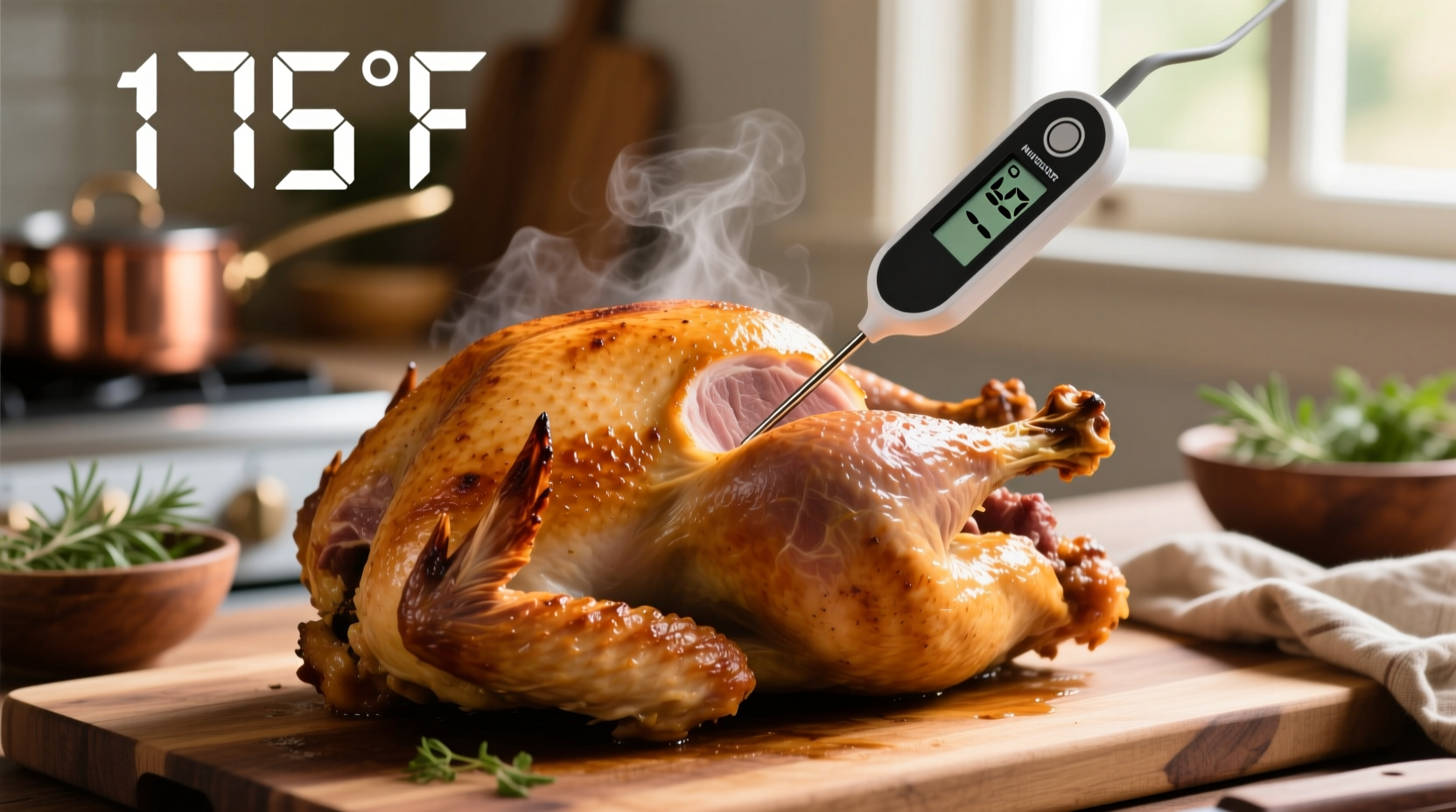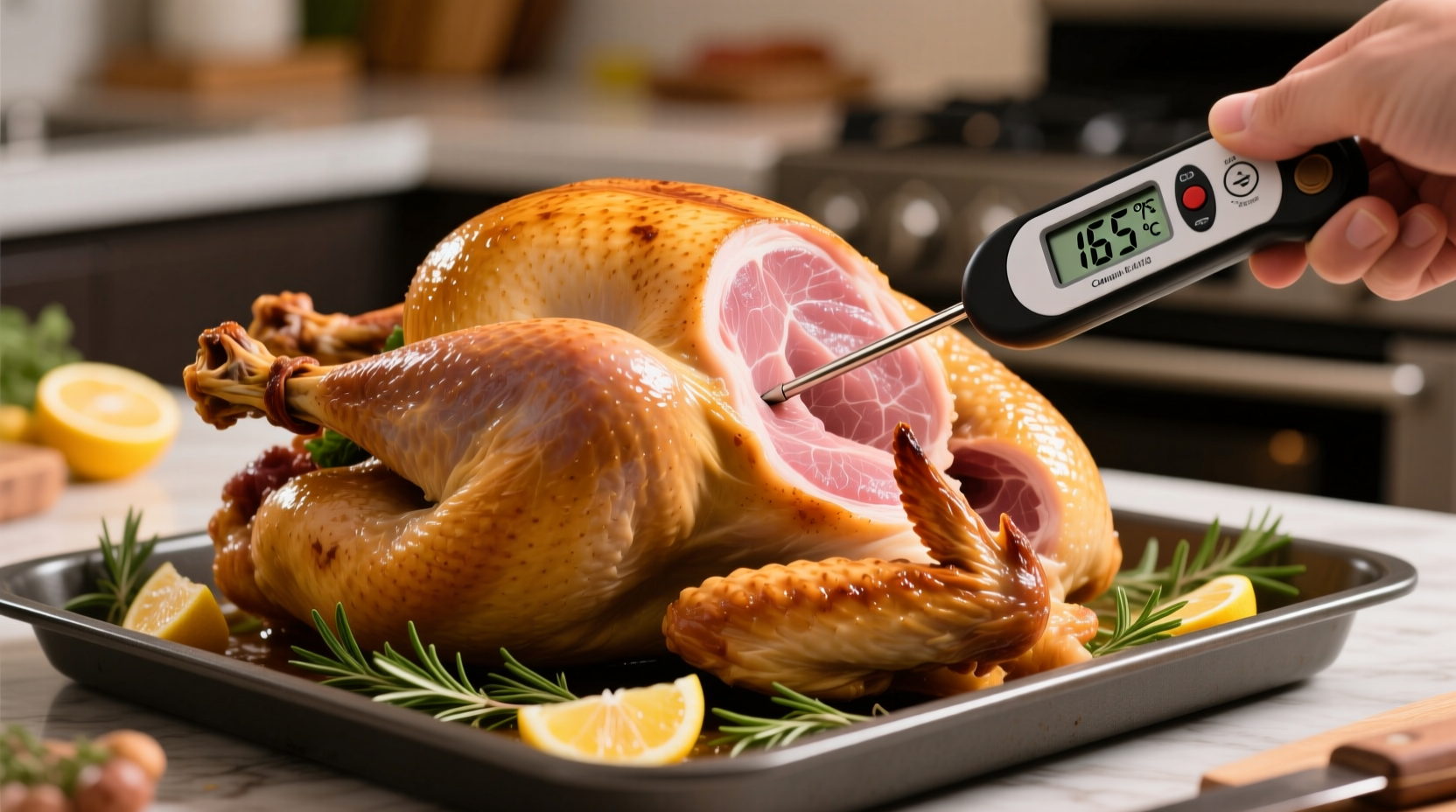The safe internal cooking temperature for turkey is 165°F (73.9°C) as measured with a food thermometer in the thickest parts of the breast, thigh, and wing. This temperature destroys harmful bacteria like Salmonella and Campylobacter while preserving juiciness.
Nothing ruins a holiday meal faster than foodborne illness. Getting the turkey temperature right isn't just about perfect texture—it's a critical food safety requirement that protects your family. Let's break down exactly how to achieve safe, delicious results every time.
Why 165°F Is the Gold Standard for Turkey Safety
The USDA Food Safety and Inspection Service has established 165°F as the minimum safe internal temperature for poultry through extensive scientific research. At this precise temperature, dangerous pathogens like Salmonella and Campylobacter—common in raw poultry—are instantly destroyed.
"Many people mistakenly believe turkey is done when juices run clear or the leg moves freely," explains Antonio Rodriguez, culinary expert with professional kitchen experience. "These visual cues are unreliable indicators of safety. Only a properly calibrated thermometer provides certainty."
| Temperature Measurement | Food Safety Status | Scientific Basis |
|---|---|---|
| 165°F (73.9°C) | Instant pathogen destruction | USDA FSIS validation studies |
| 150°F (65.6°C) | Requires 3.7 minutes at temperature | USDA thermal death time research |
| Below 140°F (60°C) | Danger zone - rapid bacterial growth | FDA Food Code guidelines |
Step-by-Step Temperature Verification Process
Accurate temperature measurement requires proper technique. Follow these steps for reliable results:
- Choose the right thermometer: Use a digital instant-read thermometer (tested to ±1°F accuracy) rather than dial thermometers which often have larger margins of error
- Target the critical zones: Insert probe into three locations:
- Thickest part of breast (avoiding bone)
- Innermost part of thigh (near joint)
- Thickest part of wing
- Wait for stabilization: Hold thermometer in place until reading stops changing (typically 10-15 seconds for digital models)
- Verify multiple spots: Check several areas in each section as heat distribution varies

Avoiding Common Temperature Mistakes
Even experienced cooks make critical errors when checking turkey temperature. Watch for these pitfalls:
- Mistake: Testing only the breast
Solution: Thigh and wing often cook slower—always check all three zones - Mistake: Inserting thermometer near bone
Solution: Bone conducts heat differently—measure in meaty areas at least 0.5 inches from bone - Mistake: Not calibrating thermometer
Solution: Test in ice water (should read 32°F) or boiling water (212°F at sea level) before use
Temperature Exceptions and Special Considerations
While 165°F remains the universal safety standard, certain cooking methods create important context boundaries:
- Sous vide preparation: Turkey can be safely cooked at lower temperatures (145-150°F) for extended periods (6+ hours) following precise time-temperature tables from the USDA
- Smoked turkey: Maintain smoker temperature between 225-250°F and verify final internal temperature reaches 165°F
- Resting period: Temperature continues rising 5-10°F during the mandatory 3-5 minute rest—remove turkey at 160-162°F for optimal juiciness
The FDA Food Code specifies that "poultry shall be cooked to 165°F or above as measured with an accurate thermometer." This regulation applies regardless of cooking method or recipe variations. When in doubt, measure again—your family's health depends on it.
Visual Indicators vs. Temperature Readings
While traditional visual cues like clear juices or leg mobility sometimes coincide with proper doneness, they're unreliable safety indicators. Research from the University of Minnesota Extension shows:
- 38% of turkeys with clear juices still tested below 160°F
- 22% showed leg mobility while remaining in the danger zone
- Only thermometer verification consistently confirmed safety
"Relying on visual cues alone is playing Russian roulette with your guests' health," Rodriguez warns. "A $10 thermometer provides certainty where experience fails."
Post-Cooking Temperature Management
Food safety continues after the turkey leaves the oven:
- Resting period: Let turkey rest 3-5 minutes before carving—this allows temperature equalization and slight carryover cooking
- Leftover handling: Refrigerate portions within 2 hours (1 hour if room temperature exceeds 90°F)
- Reheating: Heat leftovers to 165°F before serving
The CDC reports that improper handling of holiday leftovers causes thousands of foodborne illness cases annually. Proper temperature management throughout the entire cooking process—not just during roasting—is essential for safety.











 浙公网安备
33010002000092号
浙公网安备
33010002000092号 浙B2-20120091-4
浙B2-20120091-4